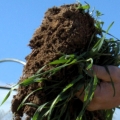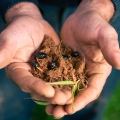Soil Safety Net – World Soil Day!
Published 20th August 2021. Written by Maddison O’Brien
World Soil Day is on December 5th! And what a perfect opportunity to reflect on the incredibly complex network of life beneath our feet! Take a moment to think about how much we rely on healthy soil to survive. We need it to grow food and crops to feed our animals. The whole food web on land begins from microscopic life in the soil. We as a global community must take care of the soil so that we can continue to feed a growing population and protect biodiversity.
Neglected and degraded soils can lead to disastrous events such as loss of topsoil, erosion and salinity. Unhealthy soil doesn’t function how it should; it’s out of balance and does not properly perform its vital role in the hydrological and mineral cycles. A calculation of current rates of soil degradation suggests we only have about 60 years of topsoil left! This startling estimate highlights the importance of radical change in how we think about and manage soil.
There are many ways to make a difference and improve the productivity and health of our soils. Increasing organic matter inputs is the most effective way to improve soil structure. This can be achieved by adding compost, manure or returning crop residues to the soil. A good layer of organic matter combined with growing plants ensures the ground is not bare and ensures higher water carrying capacity in soils. Bare soil is highly susceptible to erosion and will not allow water to infiltrate as well. The effects of soil erosion are extreme in cases like we are seeing now with large scale flooding and vast amounts of topsoil being washed into the rivers and filling dams with sediment.
Ground cover with organic matter and growing plants is the key to soil health, and the benefits of a continuous and growing layer of humus are compounding. This has become the focus of many graziers and growers in the movement known as regenerative agriculture. Regen Ag seeks to restore farm ecosystems and the environment while still achieving sustainable productivity. Not only do we have productivity benefits to gain from looking after soil, but healthy soils have a greater ability to sequester atmospheric carbon dioxide (CO2) as soil organic carbon. This is a powerful solution in the worlds race to reduce greenhouse gas emissions. So much so that productive agriculture was a focus of Australia’s plan to reduce emissions at the COP26 summit, with one of the strategies including 90 million Ha of land to be used as carbon sinks and other carbon capture methods.
We can all do things in our land management practice to take care of soil health. Take a moment to find out what you could do on your patch and get educated on the importance of soil in our Earth system. If soil health is of particular interest to you, consider joining our Microscope Group or getting in touch with us! Our website has lots of resources too. Check them out!











